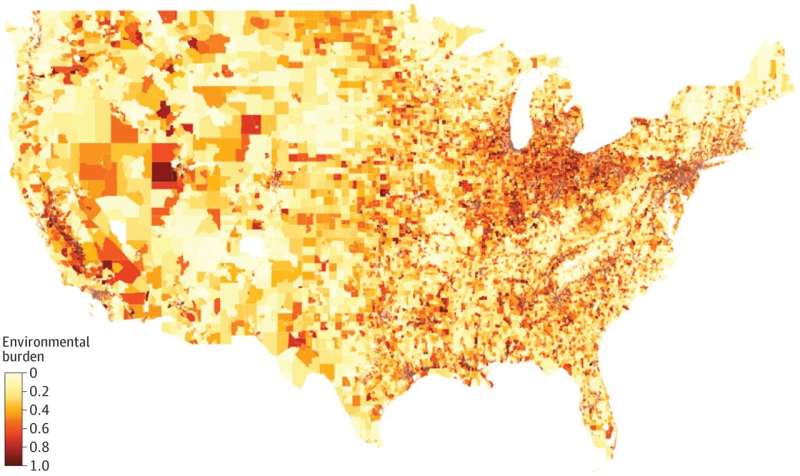This article has been reviewed according to Science X's editorial process and policies. Editors have highlighted the following attributes while ensuring the content's credibility:
fact-checked
peer-reviewed publication
trusted source
proofread
Study reveals link between neighborhood environmental burden and risk of cardiovascular disease

A national study led by investigators at Beth Israel Deaconess Medical Center (BIDMC) demonstrates that neighborhood exposure to environmental hazards is significantly associated with poor cardiovascular health across the United States.
The study, presented at the American Heart Association Scientific Sessions and simultaneously published in JAMA Cardiology, found that greater cumulative environmental burden (e.g., air pollution, nearby hazardous/toxic sites, poor built environment) was linked with a higher prevalence of cardiovascular risk factors and diseases across US neighborhoods.
"Until now, little has been known about how cumulative environmental burden affects cardiovascular health across U.S. neighborhoods, particularly among the most socially vulnerable communities nationwide," said corresponding author Rishi K. Wadhera, MD, MPP, MPhil, Section Head of Health Policy and Equity at the Richard A. and Susan F. Smith Center for Outcomes Research at BIDMC and assistant professor of medicine at Harvard Medical School (HMS).
"Our study highlights the need to intensify efforts to implement multifaceted community, public health, and policy initiatives that both identify and address environmental burdens and their negative effects on cardiovascular health."
Wadhera and colleagues looked at nearly 72,000 census tracts nationally to evaluate the possible link between neighborhood-level environmental conditions and cardiovascular health in the United States.
The team found that the link between greater cumulative environmental burden and higher prevalence of cardiovascular risk factors and diseases across U.S. neighborhoods persisted even after accounting for neighborhood age and sex composition, social vulnerability, health care access, and geography.
In addition, associations between environmental burden and cardiovascular risk factor and disease prevalence were much stronger among the most socially vulnerable neighborhoods, indicating that environmental burden disproportionately influences cardiovascular health in socioeconomically disadvantaged communities and neighborhoods with a high proportion of racial and ethnic minorities.
The researchers used the Environmental Justice Index (EBI), the first national, granular, and comprehensive measure of exposure to environmental factors influencing human health collected by the Centers for Disease Control and Prevention, U.S. Census Bureau, U.S. Environmental Protection Agency, and U.S. Mine Safety and Health Administration.
Released in 2022, the EBI was calculated at the individual neighborhood level and encompasses 17 indicators, spanning five separate domains, including air pollution; hazardous and toxic sites; the built environment, such as recreational parks and neighborhood walkability; transportation infrastructure such as high-volume roads and airports; and water pollution.
The team also looked at social vulnerability, a composite measure of demographic and socioeconomic factors that influence external stresses on human health. It encompasses 14 indicators that fall into four domains including racial and ethnic minority status; socioeconomic status; household characteristics such as disability status and English-speaking ability and housing type.
"Our study highlights that the most vulnerable neighborhoods are both disproportionately exposed to and uniquely susceptible to the health-harming effects of environmental burdens," said lead author Michael Liu, MPhil, of HMS.
"This environmental injustice, rooted in factors such as economic inequality and systemic racism, has resulted in the concentration of low-income individuals and people of color residing in close proximity to hazardous environmental exposures. The most impacted neighborhoods often lack the political power and resources to influence decision-making processes or mitigate the harms of environmental burdens."
"Efforts to improve environmental conditions in the most socially vulnerable neighborhoods could help reduce the glaring inequities in cardiovascular health across the U.S."
More information: Michael Liu et al, Neighborhood Environmental Burden and Cardiovascular Health in the US, JAMA Cardiology (2023). DOI: 10.1001/jamacardio.2023.4680




















